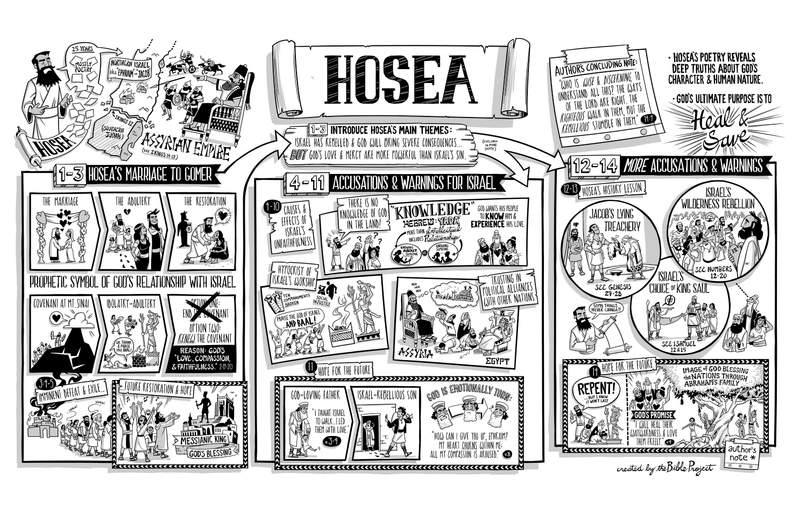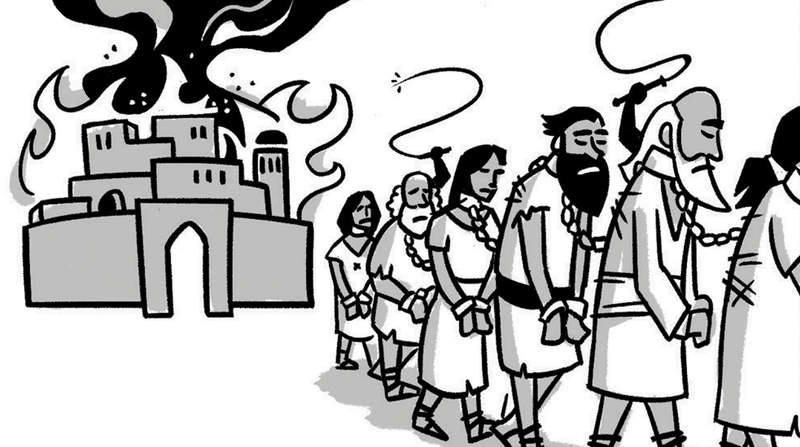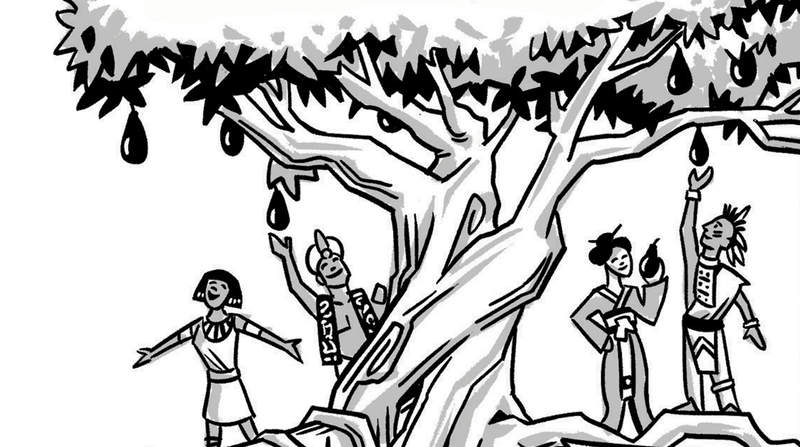The Book of Hosea
About

One important aspect of the ancient TaNaK order of the Hebrew Bible is that the 12 prophetic works of Hosea through Malachi, sometimes referred to as the Minor Prophets, were designed as a single book called The Twelve. Hosea is the first book of The Twelve.
Hosea lived in the northern kingdom of Israel about 200 years after it broke off from southern Judah (1 Kgs. 12). He was called to speak on God’s behalf to the people of Israel (who he also called “Ephraim” or “Jacob”) during the reign of one of Israel’s worst kings, Jeroboam II. This king led the nation into chaos from which it never recovered. In the year 722 B.C.E., the big bad Assyrian empire would swoop in to destroy Israel (2 Kgs. 14-17), and Hosea had seen it all coming.
The book is a collection of some twenty-five years worth of his preaching and writing, almost all of which is in the form of poetry. The book has been designed to have three main sections, consisting of chapters 1-3, 4-11, and 12-14.
Who Wrote the Book of Hosea?
Context
Key Themes
- God’s faithfulness to Israel despite Israel’s unfaithfulness
- God’s promise to save and heal Israel from its waywardness
- Forgiveness and mercy
- Covenant fulfillment through Israel to the nations
Structure
Hosea 1-3: A Broken Marriage Symbolizing God’s Covenant With Israel
The opening section tells the story of Hosea’s broken marriage to a woman named Gomer, who commits adultery. While it’s not clear whether or not Gomer kept lovers before or only after they got married, she and Hosea had three children together. Things fell apart between them, but God told Hosea that, despite Gomer’s unfaithfulness, he was to find her and pay off the debts she owed to her other partners. Then he was to commit his love and faithfulness to her once again. God then says that these circumstances—the broken and repaired marriage and the children—are prophetic symbols that tell the story of God’s relationship with Israel.
God has been like a faithful husband to Israel. He rescued them out of slavery in Egypt and entered into a covenant with them at Mount Sinai, where he asked them to be faithful to him alone. When God brought them into the promised land, however, Israel took all the abundance that he provided for them—such as grain, wine, and oil—and dedicated it to the worship of the Canaanite god, Baal. Therefore, God has a legitimate reason to end the covenant and divorce Israel. But after considering it, God instead says that he’s going to pursue Israel once again and renew the covenant, purely because of his own “love, compassion, and faithfulness” (Hos. 2:19-20).
Hosea spells out exactly what all this means. The consequence of Israel’s rebellion will be imminent defeat by other nations and exile, but there is still hope for future restoration. One day, Israel will repent and come back to worship their God. And in response, God will bring them a new messianic king from the line of David who will bring God’s blessing.

These opening chapters (chs. 1-3) introduce all the main ideas of the book of Hosea. Israel’s rebellion will bring severe consequences, but God’s own covenant love and mercy are more powerful and will open the way to a new future. In the remaining sections of the book, Hosea’s flowing poetry explores these themes in more depth. There are two collections of his accusations and warnings for Israel (chs. 4-11 and 12-14), each concluded by a hopeful poem about God’s mercy (chs. 11 and 14).
Hosea 4-14: Israel’s Unfaithfulness and God’s Compassion
In chapters 4-10, Hosea explores the causes and effects of Israel’s unfaithfulness. He says numerous times that Israel lacks all “knowledge” or “understanding” of God. The Hebrew word yada, “to know,��” is about more than just intellectual activity. It’s personal, relational knowledge. It’s the difference between knowing about someone and knowing that person. God wants Israel to know him in a committed relationship and to experience his love for them. That’s the kind of knowledge that transforms people's hearts and lives.
This is why Hosea is constantly exposing the hypocrisy of Israel’s worship. He shows how they constantly break the Ten Commandments. They allow grave injustice within their communities, and then they go to their sacred temples and offer sacrifices to God like everything is fine. But things are not fine, not only because of their hypocrisy, but also because they worship many other gods, like Baal.
Just like Israel has given their allegiance to false gods, they have also put trust in their political alliances with Egypt and Assyria. Instead of trusting in God to protect them, they want to become more like these other nations and rely solely on military power. So God says it’s all going to come crashing down on their heads. Not too long from now, Assyria will turn on Israel and come to ravage their lands.
In chapters 12-13, Hosea gives an Israelite history lesson to show just how unfaithful they’ve been from the very beginning. He alludes to the patriarch Jacob’s lying and treachery (Gen. 27-28), to Israel’s rebellion in the wilderness (Num. 12-20), and to their appointment of the corrupt King Saul, who led them into disaster (1 Sam. 12; 1 Sam. 15). This is Hosea’s way of saying that some things never change.
It’s easy to lose hope here, but remember that in chapter 3, God said he had a plan to save and restore his people. Chapter 11 illustrates this turning point well. It’s a beautiful poem that depicts God as a loving father who raised his son Israel and shared everything with him. But his son has rebelled and turned on him by taking advantage of his father’s generosity. In this poem, God is emotionally torn apart. He’s angry, naturally, and he says that he’ll bring down severe consequences. But God’s anger quickly turns to heartbreak, and he’s moved by mercy and compassion to forgive the son he loves. He says, “How can I give you up, Ephraim? My heart churns inside me, all my compassion is aroused” (Hos. 11:8). So while God did allow Israel to be conquered by Assyria, it’s not the end of the relationship. God still loves Israel with a passion and wants to save his people.

That is what the last chapter (ch. 14) explores. Hosea calls on Israel to repent and turn back to their God, but he knows it won’t last. It never does. But God says that one day he will “heal their waywardness and love them freely” (Hos. 14:4). He goes on to describe this new, healed Israel as a lush tree that will grow deep roots and broad branches, offering shade and fruit to the nations. It’s a beautiful image of God’s promise to Abraham that Israel would become a blessing to the nations. However, if that’s ever going to happen, it will require an act of God’s healing power to repair the deep brokenness and selfishness of the human heart, so that his people can truly receive his love and love him in return. God promises to do just that.
After this poem concludes, we find the last verse of the book of Hosea. It’s an appended note, likely from the author who collected Hosea’s poetry. The note addresses you, the reader: “Who is wise and discerning to understand all this? The ways of the Lord are right. The righteous walk in them, but the rebellious stumble in them.” (Hos. 14:9) The author wants you to know that Hosea’s ancient poetry to northern Israel is not locked in the past. It reveals deep truths about God’s character and human nature and about the future of God’s covenant people. While God should and sometimes does bring his justice upon human evil, his purpose and his heart is ultimately to heal and to save. And that is Hosea’s message to all future generations.